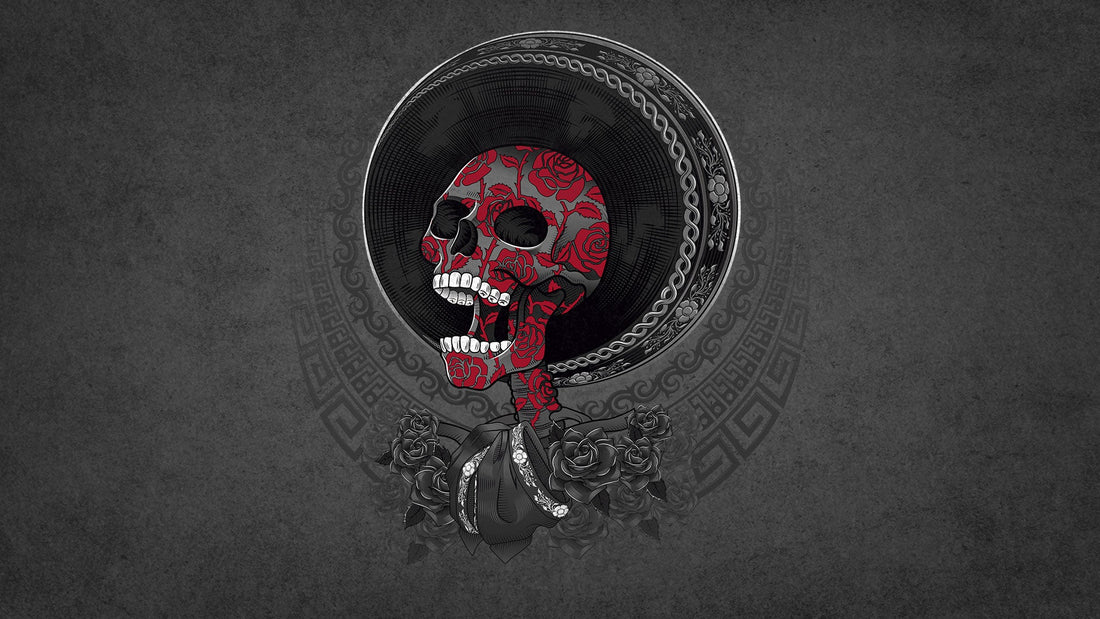The Legend of La Risueña: The Joyful Face of Death and Life

Share
In the mystical universe of the Day of the Dead, where souls and the living meet in a vibrant celebration, the figure of La Risueña emerges, a unique Catrina who not only celebrates death but also life with a wide, contagious smile. With her mouth always open in an eternal laugh, La Risueña is a reminder of the mischief and humor that Mexicans find even in the most solemn moments.
La Risueña's design presents her as an exuberant Catrina, with a face sculpted in floral details and thorns, symbolizing the beauty and adversities of life. Her skull is adorned with delicate flowers that bloom around her eyes and cheeks, reminding us that in every phase of life, including death, there is beauty and rebirth. The thorns surrounding her face symbolize the challenges and struggles that are part of the journey, but do not define her. Those thorns, though sharp, do not dull her smile, but rather reinforce it, showing how resilience and humor can flourish even in the most difficult circumstances.
The legend of La Risueña tells us that in life, she was a woman known for her cheerful and joking nature. She always found a reason to laugh, even in the darkest moments, and her laughter was contagious, lighting up any room she entered. She firmly believed that death shouldn't be feared, but celebrated, as it was merely a transition to another state of existence. So, when her time came to depart, La Risueña didn't cry or fear; instead, she laughed, embracing death with the same joy she had lived her life.
In the afterlife, La Risueña became one of the most beloved figures during the Day of the Dead. With her mouth always open in eternal laughter, she symbolizes the Mexican people's ability to find humor and joy even in the most serious aspects of life. Each year, when offerings are placed and altars are filled with flowers, her spirit is invoked during the festivities, bringing with her laughter and a reminder that death is not the end, but part of a cycle.
La Risueña is also known for her ability to play tricks on newly arrived souls at Mictlán, the Aztec underworld. Legend has it that when a new soul arrives, nervous and confused by the transition from life to death, La Risueña greets them with a joke, allaying their fears and making them feel welcome. "Why fear the inevitable?" her laughter seems to say, "life and death are just two sides of the same coin."
With its combination of flowers and thorns, La Risueña represents the balance between beauty and difficulty, between joy and suffering. Her face, decorated with floral details, not only embellishes her skull but also symbolizes the cycle of life, death, and rebirth, while the thorns surrounding her remind us that life is full of challenges, but it is our attitude toward them that defines how we face them.
Today, La Risueña's design is a tribute to the Mexican spirit that celebrates life with humor, even in the face of death. Her eternal laughter resonates from every altar, every sugar skull, and every heart that celebrates the Day of the Dead, inspiring everyone to smile in the face of the inevitable and enjoy every moment, remembering that, in the end, laughter is the greatest testament to a life well lived.
La Risueña's design presents her as an exuberant Catrina, with a face sculpted in floral details and thorns, symbolizing the beauty and adversities of life. Her skull is adorned with delicate flowers that bloom around her eyes and cheeks, reminding us that in every phase of life, including death, there is beauty and rebirth. The thorns surrounding her face symbolize the challenges and struggles that are part of the journey, but do not define her. Those thorns, though sharp, do not dull her smile, but rather reinforce it, showing how resilience and humor can flourish even in the most difficult circumstances.
The legend of La Risueña tells us that in life, she was a woman known for her cheerful and joking nature. She always found a reason to laugh, even in the darkest moments, and her laughter was contagious, lighting up any room she entered. She firmly believed that death shouldn't be feared, but celebrated, as it was merely a transition to another state of existence. So, when her time came to depart, La Risueña didn't cry or fear; instead, she laughed, embracing death with the same joy she had lived her life.
In the afterlife, La Risueña became one of the most beloved figures during the Day of the Dead. With her mouth always open in eternal laughter, she symbolizes the Mexican people's ability to find humor and joy even in the most serious aspects of life. Each year, when offerings are placed and altars are filled with flowers, her spirit is invoked during the festivities, bringing with her laughter and a reminder that death is not the end, but part of a cycle.
La Risueña is also known for her ability to play tricks on newly arrived souls at Mictlán, the Aztec underworld. Legend has it that when a new soul arrives, nervous and confused by the transition from life to death, La Risueña greets them with a joke, allaying their fears and making them feel welcome. "Why fear the inevitable?" her laughter seems to say, "life and death are just two sides of the same coin."
With its combination of flowers and thorns, La Risueña represents the balance between beauty and difficulty, between joy and suffering. Her face, decorated with floral details, not only embellishes her skull but also symbolizes the cycle of life, death, and rebirth, while the thorns surrounding her remind us that life is full of challenges, but it is our attitude toward them that defines how we face them.
Today, La Risueña's design is a tribute to the Mexican spirit that celebrates life with humor, even in the face of death. Her eternal laughter resonates from every altar, every sugar skull, and every heart that celebrates the Day of the Dead, inspiring everyone to smile in the face of the inevitable and enjoy every moment, remembering that, in the end, laughter is the greatest testament to a life well lived.
